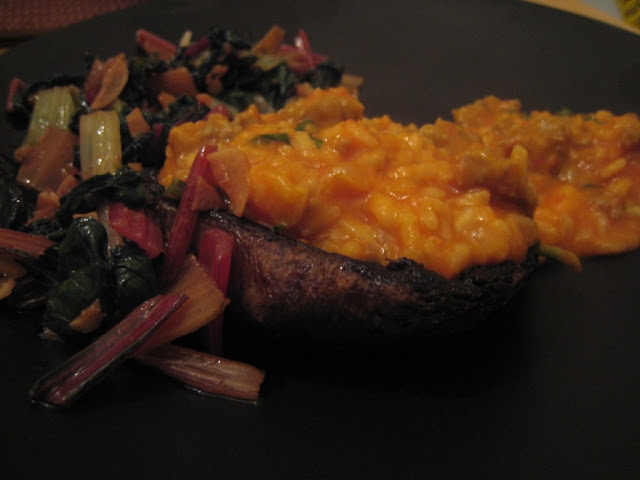Today we contemplate the stuffed pepper. Who would ever think to take a large, cavernous vegetable, hollow it out, cram it full of goodness, and then roast it and treat it like an edible bowl? Well, I don't know, but let's hope that he was given a thousand virgins and quite a few goats for his discovery. You could do this with tomatoes, peppers, or eggplant or squash if you really knew what you were doing. But as an easy start, let's focus on the most forgiving of all of these from a cooking and structural integrity standpoint - the pepper. If you don't like bell peppers, then I have nothing for you. But consider that you may only dislike green bell peppers, which are slightly less sweet, and consider giving this a try.
Bell Peppers Stuffed with Sausage and Rice
by me
- 2 large red bell peppers
- 1/2 lb Italian sweet or hot sausage, removed from casings if present
- 1 small zucchini, diced
- 2 cloves garlic, minced
- 1 small onion, diced
- 1 rib celery, diced
- 1 green onion, sliced thinly
- 1/2 c coarse breadcrumbs
- 2 oz firm aged cheese, such as Parmesan or Asiago, grated
- 1.5 c cooked brown (or white) rice
- 2 tbsp olive oil
- Salt and pepper
- tomato sauce or aged balsamic vinegar, for plating
- 1 tbsp parsley, minced, for plating
 |
| The peppers loaf about lazily on the countertop, unaware of their fate. |
Preheat your oven to 400 deg F.
Begin by halving the peppers lengthwise, removing the core and seeds, and cutting away as much of the white membrance as you can (this is bitter, and also takes up space). Now, in a large saute pan over high heat, brown the sausage in 1 tbsp olive oil, breaking up with your spoon into small pieces. When browned, remove from pan and drain on a paper towel, and saute zucchini, garlic, onion, celery, and green onion in the next 1 tbsp of olive oil. Remove to a large bowl.
In the meantime, take a small frying pan and heat the last 1 tbsp of olive oil. Toast the breadcrumbs if they're not already toasty, and set aside.
Now, the rest is fairly straightforward. Take everything you've got except the peppers themselves and the breadcrumbs, and stir them together in a big bowl. Taste, and season as needed with salt and pepper. Try not to just stop here and eat the whole thing, because you will probably want to. But we must forge ahead - now stuff this into the pepper halves, packing in the filling somewhat densely and mounding up slightly. Don't get so crazy that it's spilling out, because next you have to sprinkle on the toasted breadcrumbs.
 |
| The filling, resting before an epic journey in a hollowed out pepper through the fires of Mt. Ofen. |
 |
| The peppers, packed and ready to go. |
In a reasonably sized glass baking dish, brush a few drops of olive oil onto the bottom and situate the pepper halves. Toss in the oven for about 30 minutes, until peppers are soft and starting to brown at the edges, and bread crumbs are brown on top.
To serve, either place on a bed of homemade marinara sauce, or drizzle with balsamic vinegar, as I have done. I tried this both ways and preferred the tomato sauce version, but both are going to impress people. Sprinkle with minced parsley, and serve.
 |
| Exhausted from their journey, the peppers lie unsuspectingly before hungry predators. |
 |
| At last, the stuffed pepper has come to its final resting place |





















